Morocco
Day One
Lunch
After being introduced to the Moroccan tea ceremony and the distinctive, refreshing Moroccan mint tea (essentially Chinese green tea leaves [gunpowder or zhu cha], a generous handful of fresh mint, boiling water and an extraordinary amount of sugar), we decided to venture out into Marrakech in search of lunch.
We decided to eat on the fringes of Djemâa el-Fna, the central square and undoubted focal point of Marrakchi daily life, where people meet and tourists get fleeced. This was where we were first introduced to the standard Moroccan meal of bread, salad and tajine.
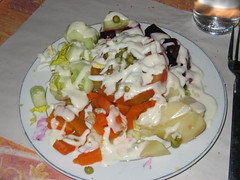
Our salad was a melange of tomatoes, lettuce, carrots, potatoes, beets and chickpeas, slathered in a creamy but mild mayonnaise. Surprisingly, this combination of vegetables, roots and legumes proved to be extremely refreshing, a feature characteristic of Moroccan salads, which are disarmingly simple, but always tasteful.
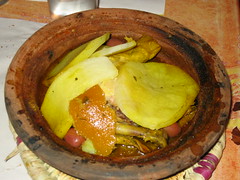
A tajinerefers to both the distinctive, conical earthenware container, and the resulting meal that is prepared in the container. Meats and vegetables are cooked in the tajine, resulting in a scaldingly hot stew that is replete with exotic spices and flavours. This one was a chicken tajine, redolent with cumin, preserved lemons and olives. Tajines are not meant to be subtle, and this was most definitely was not. Unabashedly flavourful, I very much enjoyed my first tajine, and looked forward to the many more I knew would come.
Dinner

Dinner would also be in Djemâa el-Fna, but this time we would be eating in the square itself, following in the footsteps of Anthony Bourdain in his Cook’s Tour. Of course, we’d already heard and read about the infamous sheep’s head dish, and were intrigued to see what else could be found for sale. The night bazaar of Djemâa el-Fna is the ultimate in street food, putting Newton Hawker Centre to shame with its lights, smells, sounds and atmosphere.
Orange juice vendors beckon to you, calling out their 3 Dh fresh orange juice, roughly $0.60 and the best orange juice I have ever tasted. Mounds of dried dates and figs, candied fruits and other unidentifiable tid-bits surround you and attract inquisitive glances. Spiced ginseng tea and curious Moroccan desserts can be found nearby. Djemâa el-Fna is a riotous experience, and we were there to soak it all in.

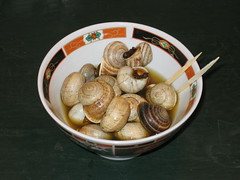
Some of the more curious stalls are the ones that sell snails. These are not the refined escargot of French cuisine, just a big pile of snails in a bowl full of suspicious liquid, periodically being stirred by the vendors, the snails’ shells clacking noisily against each other. I tried one, and can’t say I’m a fan – it tasted like what a snail would presumably taste like, slightly savoury, slightly rubbery. All in all I preferred the French interpretation.
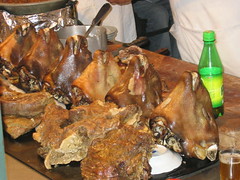
Sheeps’ heads, we decided, were more palatable from a safe distance, and in consideration of our long trip ahead and interest in our continued well-being, we decided to leave this Moroccan delicacy to the locals.
One stall in particular was producing copious amounts of smoke and flame from its barbecue grill. Turns out they did sausages and other meaty products. We decided to sit down to sample their wares.
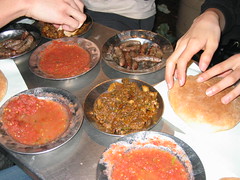
Bread, with a tasty tomato dip to go along, as well as a dish of sausages. It’s best not to think about where the meat in those sausages came from, and to simply enjoy them. They were good when warm, but tasted a bit odd when they started cooling down, and the oil and fat that congealed around them as they cooled made them quite unappetising.
We were also provided a dish of mysterious meat, which could have been anything from kidneys to sausage stuffing and everything in between, but were in any event delicious and undoubtedly unhealthy.
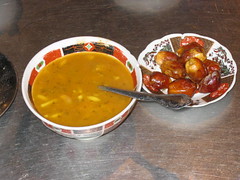
Not completely satisfied with our meal, we wandered the square in search of new experiences, trying some bread stuffed with potatoes, boiled egg and dressed with oil; as well as harira, the local lentil and chickpea soup that came with dates. Satisfying and warming on a cold evening, the soup was popular among the locals.
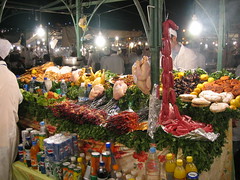

Next, we came to a stall serving brochettes, kebab-like skewers of grilled meat and vegetables. Personally I’m not a great fan of kebabs and brochettes (though I do enjoy satay), and I thought we got ripped off on this last stall, but otherwise our dining experience in Djemâa el-Fna was a most rewarding one.
Day Two
Lunch
Our second day in Morocco saw us travelling out of Marrakech, to spend the next three days and two nights in the eastbound wilderness of Ouarzarzate, Tinerhir and the Sahara desert. After an arduous bus ride, we managed to make a stop in Ouarzarzate for an over-priced lunch aimed at the captive market of tourists on the well-travelled route.
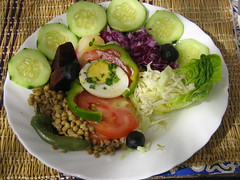
Another variation of Moroccan salad, this time with cucumber, red and green lettuce, beet, peppers, tomatoes and chickpeas. No sauce, but the salad was similarly enjoyable, with the different textures and tastes playing off each other despite, or perhaps because, of its plainness.
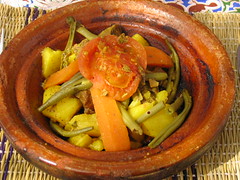
Another tajine (Moroccan cuisine is not well-known for its inventiveness), but this one was not as polished, it seemed dry and insipid, despite the addition of a tomato and some beans.
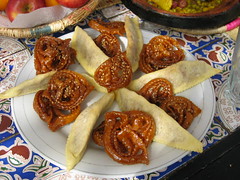
Moroccan dessert takes the form of assorted candy and pastries. Coated with caramelised sugar and sesame seeds or filled with a coconut-nougat filling, Moroccan candy is well-suited to the national sweet tooth, but can be quite dry and does not rank highly as one of my favoured desserts.
Dinner
Dinner in the Dadès Gorge was fairly unremarkable, merely more harira and another tajine, though the soup had been quite watered down and the tajine was uninspired.
Day Three
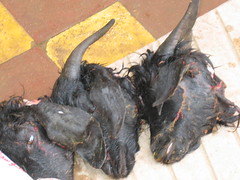
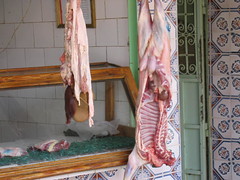
What was more interesting was the first-hand look at Moroccan butchery, and a good reminder of just where the food ultimately comes from. Bisected carcasses and disembodied goats’ heads adorn the stalls of many butchers throughout Morocco. Watching the butchers saw through some of the carcasses with the help of a handsaw, I felt glad that I would never have to buy meat from Morocco. It’s not that I can’t deal with raw meat, nor am I ignorant of the fact that the meat we consume used to be a living, breathing animal, but the way the meat is laid out: the spines, limbs and tails splayed and displayed, makes it seem so much more visceral and unpleasant.
Day Four
Breakfast
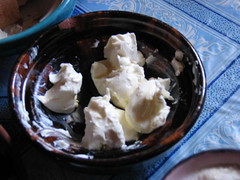
After spending the night out in the Sahara desert, we had a traditional Moroccan breakfast of round loaves of bread, consumed with simple accompaniments like butter, marmalade and olive oil. Interestingly, the butter we were served was pure white, very smooth and creamy, with little of the oleaginousness of normal butter. I was inclined to believe it was goat’s milk butter, but I was told it was normal cow’s butter, though that might have had something to do with my awkward French.
Lunch

Lunch involved another variation on the Moroccan salad, this time with tomato concassé, olives, lettuce, cucumbers and red onions. As always, it was deliciously refreshing, clean and simple.
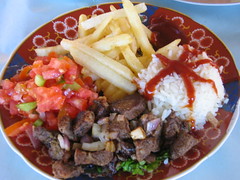
For a change, I decided to have a brochette, imagining a tasty skewer of grilled meat. Unfortunately, I was somewhat disappointed; the meat was dry and the portions were parsimonious. What few fries there were weren’t even crispy, and the rice was barely decent.
Dinner
We decided to treat ourselves to a lavish dinner though, to celebrate our surviving the twelve-hour bus ride back to Marrakech. With the help of the hostel-owner, we were able to make a reservation at an upmarket but classic Moroccan restaurant, Le Kossour Essaoussan (Rue des Ksour, 3 Derb El Messaoudyenne). Amazingly, this restaurant was located in a dingy, barely-lit alleyway that looked like any one of the numerous dingy, barely-lit alleyways that make up the medina of Marrakech; hardly the venue one would expect to find a classy restaurant.
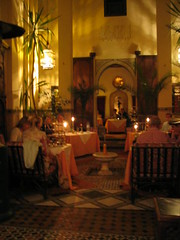
The décor of the restaurant resembles an old-fashioned Moroccan riad, with water features, divans, plant life and soft lighting all designed to evoke a sense of harmony and tranquility. Folded napkins and pure-white tablecloths emphasised the exclusivity of the restaurant, and suggested Moroccan fine-dining in a more Occidental setting. Service was prompt and professional, despite our obvious youth and tourist-scruffiness.
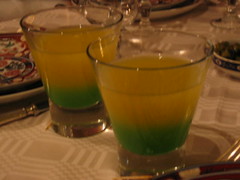
The 350 Dh ($70) prix fixe menu includes an aperitif, water, half-bottle of wine/cocktail, starter, main course and dessert; with generous portions in each course.

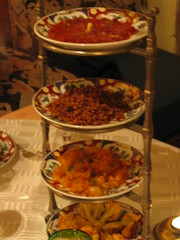
Our starters were somewhat like Moroccan tapas: tomato confit, lentils, cauliflower, sliced courgettes, pumpkin purée – just enough to whet the appetite with a variety of flavours to prepare us for the main dishes.

I had a lamb cous cous, which came stuffed to the brim with chickpeas, some carrots, and of course, the cous cous itself, which was light, fluffy, and incredibly filling. Although the individual semolina grains are negligible, finishing the entire dish of cous cous, with the chickpeas, braised lamb and carrots, was quite a task. But the dish itself was delicious, and the cous cous, despite being so filling, was never stodgy or starchy, but airy and pillowy.
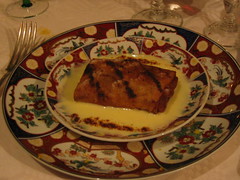
Dessert took the form of a sweet pastilla, a crispy, flaky filo-like pastry that encased tea-infused poached apples in a mild custard sauce. As I’m not a great fan of fruit-based desserts, I didn’t really enjoy this, but apple strudel aficionados would love it.
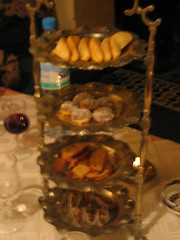
We had a selection of Moroccan sweets and petit fours, most containing a variation of chocolates, grated coconut and nuts, but by this time we were all so full that we could barely manage more than one or two. Still, it was an eye-opening experience to have enjoyed true Moroccan cuisine at such a high level, in such lavish surroundings.
Day Five
Lunch
Taking a day trip out of Marrakech, we travelled west to the coastal town of Essaouira, famed for its scenic backdrops (the site of Orson Welles’ Othello) and fresh seafood.
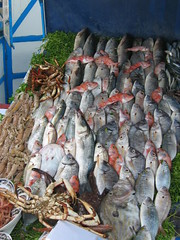
It was the latter we had come for, as we were looking forward to a lunch of grilled fish by the shore. There are many such stalls prominently displaying the catches of the day, and allow you to choose which fish you wish to eat, priced by weight and cooked on the spot.
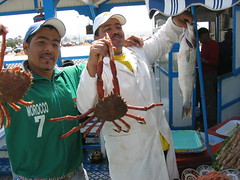
After some haggling with the enthusiastic stall keepers, we sat down to have our meal.
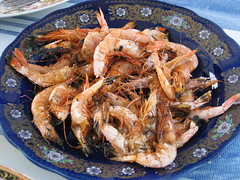
The prawns, cooked simply over a hot plate and seasoned with some salt and lemon juice, were bursting with flavour and freshness, their natural sweetness accentuated by the simplicity of their treatment.
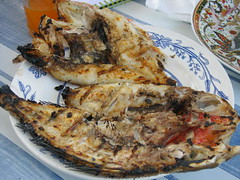
I tend not to pay much attention to seafood, which is probably why I’ve forgotten exactly what we ordered, though I believe one of the fish was a red snapper, and the other possibly a perch. These turned out quite well, just slightly toasted while the flesh underneath remained flaky and soft. The smokiness imparted by the fire was the only seasoning required; anything else would have detracted from the clean, piscine taste of the fish.
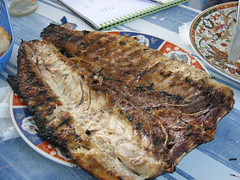
Our last fish, unfortunately, was dry and overcooked, owing perhaps in part to its large size. Still, its freshness was able to mask the deficiency in texture, and in terms of taste there was little to complain about.
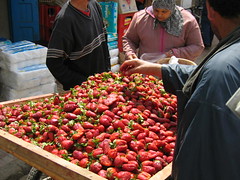
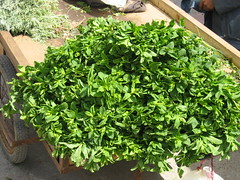
Wandering around Essaouira, we discovered that it was market day, with piles of fresh strawberries and mint for sale. Surprisingly, fruits and herbs do not feature prominently in Moroccan cooking, despite their abundance.
Dinner
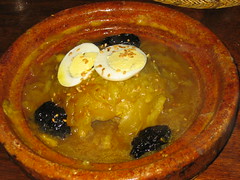
Returning to Marrakech, we had dinner once again in one of the restaurants that fringe Djemâa el-Fna. Chez Chegrouni apparently serves some of the best tajines in Marrakech, and I was particularly taken with the lamb and prune tajine. Served with onions, slow-cooked till they’ve achieved the sweetness of a French onion soup, the dulcet flavours of this tajine is emphasised by the prunes and tender lamb. The boiled eggs serve to add a dimension of texture and savouriness that offsets the overall sweetness of the dish, and I wolfed the whole thing down quite quickly.
Day Six
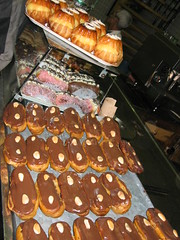
Leaving Marrakech, we lost ourselves in the complex warren of souks and alleys that make up the medina of Fès, coming across a patisserie that made some amazing éclairs. Filled with a rich custard, they made the perfect afternoon snack as we explored the old city.



No comments:
Post a Comment